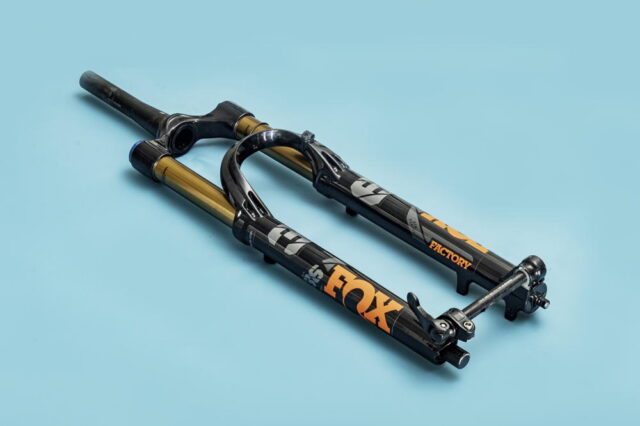There’s one type of mountain bike rider that we all secretly love to hate, and that’s the trail rider. They may be fun to watch, but always seem to out ride us on the trail and get annoyed that we’re not doing the same moves. However, we don’t hate them for being good, we hate them for making us feel bad about ourselves. And that’s why we wanted to do a thorough review of the top mountain bike suspension forks on the market. . . .
Most mountain bikers are familiar with fork manufacturers Fox, Marzocchi, Fox Racing Shox, RockShox and Manitou. But what about the other companies that have been in the industry for more than a decade? Well, here’s a list of a few of the most notable that offer their own suspension forks.
The mountain bike suspension fork is a popular addition to most mountain bike builds. There are a range of options available to you: full suspension, semi-suspension, or no suspension at all. Perhaps unsurprisingly, full suspension forks are the most expensive option. However, if you are after the performance benefits of a full suspension fork, it is worth considering.. Read more about best budget suspension fork and let us know what you think.
Looking for the finest suspension fork for your mountain bike? You’ve arrived to the correct location. One of the most expensive – and possibly most effective – improvements you can make to your mountain bike is purchasing a new suspension fork. Even when purchasing a whole bike, the fork is an important factor.
In any case, you’ll want a suspension fork that smooths out even the sharpest trail feedback, enabling your hands to endure longer on even the most difficult trails.
To keep your front wheel firmly planted on the ground, the fork should sit smoothly into the initial portion of its journey. Simultaneously, it must provide sufficient support later in the journey to prevent the bike from pitching and plunging excessively.
You’ll also want enough stiffness and adjustability to fine-tune the fork to your specific requirements, but not so much that it’s a pain to set up. You presumably want it to be as light as feasible and as inexpensive as possible!
We evaluated forks to fit a wide variety of budgets, making sure to include some top-of-the-line choices since that’s what most people purchase as a bike update.
To make the comparison fair, we evaluated 10 trail/enduro forks with 160mm travel, 29in spacing, and 51mm offset. All of these forks, of course, come with a variety of wheel sizes, travel, and offset choices.
How did we do our research?
We tested all ten forks on the same bike with the same tyre pressures, then assessed sag and checked how much travel we could utilize by squeezing the forks as much as we could to bring the forks in the same ballpark.
This article will show you how to properly set up a fork.
Then we rode each fork on a variety of terrain, fine-tuning air pressure, volume spacers, and damping settings until we were confident that the forks were performing optimally for the terrain and rider.
We next put them through their paces on a few select test courses, rapidly switching forks between runs to obtain the most accurate picture of how they stack up.
In this video, you can learn more about the procedure and how the 10 forks compared.
The finest suspension forks for mountain bikes in 2023
- £989 / $999 for the Lyrik RC2 by RockShox (2019).
- £1,139 for the GRIP2 Fox 36 Factory.
- £899.99 / $999.99 / €1,050 Mezzer Pro by Manitou (2023)
- £749 for the Bomber Z1 Marzocchi.
- £695 / AU$1,200 Yari RC Debonair by RockShox
- £925 F 535 ONE DT Swiss
RockShox Lyrik RC2 (2019)
Steve Behr’s RockShox Lyrik RC2.
- The cost is £989 / $999.
- 27.5in (tested) and 29in (tested) wheels with 150mm, 160mm (tested), 170mm, and 180mm travel
- 2,019g (about) (29in x 160mm)
This is our favorite enduro and trail bike. When starting a turn or pattering over stutter bumps, the Lyrik has the greatest off-the-top sensitivity in the class, which translates to a more settled, stuck down feel and greater traction.
It also has a wide range of damping adjustment, with the most open settings offering a super-supple and pleasant ride even on the longest and most difficult courses.
Under severe braking, the spring keeps the fork high in its travel, providing predictable and reliable support.
However, the setup isn’t completely simple. We recommend removing one or both of the volume spacers included with the 160mm-travel fork and applying much more pressure than RockShox suggests.
The Fox 36 GRIP2, which was somewhat more controllable in certain uncommon circumstances but not as supple over tiny bumps, was the only fork that came close to matching the Lyrik’s performance. Overall, we liked the Lyrik’s performance, which is also much less expensive.
We’ve also rode the 2023 Lyrik Ultimate, which provides even more comfort and puts the Lyrik ahead of the competition.
Fox 36 Factory GRIP2
Steve Behr’s Fox 36 Factory GRIP2.
- £1,139 price
- 27.5in with 160, 170, and 180mm travel; 29in with 160 (tested), 170mm travel
- 2,091g (about) (29in x 160mm)
The Fox 36 GRIP2 Factory is the most expensive fork we’ve ever tested. Fortunately, it matches in terms of performance.
Its four-way adjustable damper allows compression and rebound damping to be adjusted at high and low speeds. Fortunately, despite the wide range of changes, Fox nailed the setup instructions, making it one of the simplest forks to get in the correct ballpark.
It’s also one of the better performers, especially over large holes and choppy, uncertain terrain, where the independent high-speed rebound adjustment seems to make it more controlled and calm when returning from deep in the stroke if you’re running a lot of pressure in the spring, as we are.
It isn’t nearly as responsive off the top of the stroke as its arch competitor, the RockShox Lyrik, thus traction in low-load conditions isn’t quite as good.
Even with the compression damping completely open, it’s a bit stingy with its travel over larger hits, while being extremely active and supple over tiny bumps. This isn’t inherently a negative thing, but for long-run comfort, we’d like the high-speed compression to be a bit more open.
The 36 was the greatest fork we’ve ever used in certain circumstances, but we prefer the Lyrik overall because it has greater traction and sensitivity. It’s also less expensive.
Manitou Mezzer Pro (2023)
I was blown away with the fork’s performance. Alex Evans is a writer who lives in the United
- £1,050 (£899.99 / $999.99 / £899.99)
- 27.5in and 29in (tested) wheel sizes, both changeable between 140 and 180mm in 10mm increments. 160mm was put to the test.
- 2,093g (about) (29in x 160mm)
The Mezzer is a pleasant surprise, with a good mix of tiny bump sensitivity and bottom-out resistance. It’s very competent, no matter how far along it’s journey or how hard you push it.
The chassis also strikes the ideal mix of control, precision, and compliance, feeling rigid when it needs to be – such as under a turn – but not bouncing or juddering our front wheel off, reducing hand strain.
The high-speed compression of the MC2 damper is light enough to absorb rapid impacts and has proven to be very supple. Its low-speed damping adds to the air spring’s remarkable capabilities by providing lots of assistance during twists and compressions.
Although the air spring is difficult to set up – and you must follow the provided instructions to the letter – once it is, the performance it unlocks is almost unrivaled on the trail.
If you’re in the market for a new fork and have been contemplating the RockShox Lyrik or Fox 36 GRIP2, the Mezzer should be on your list as well.
The Manitou Mezzer was not evaluated as part of this fork group test, and it does not appear in the film, but it was tested and graded to the same standards, and it performed well.
Marzocchi Bomber Z1
Bomber Z1 by Marzocchi. Steve Behr
- The cost is £749
- 27.5in wheels with 130, 140, 150, 160, 170mm travel; 29in wheels with 150, 160 (tested), 170, 180mm travel
- 2,249g (about) (29in x 160mm)
Marzocchi is now a Fox sister brand, and the Z1 has many of the same features as the Fox 36 but is priced cheaper.
It’s one of the heaviest enduro forks on the market at 2,249g, but the additional weight isn’t really apparent on the trail due to the lower-grade aluminum used in the upper tubes.
Because the Z1 isn’t as soft at the start of its journey as the Fox 36, Yari, or Lyrik, it requires a lower air pressure to properly sag, as well as a good stack of volume spacers to prevent it from utilizing all of its travel too quickly.
It canters a little more readily in the center of its journey than the other forks, making it seem a little less predictable and polished. On the other hand, it eats kerb-sized pebbles like a champ, resulting in excellent long-run comfort.
The RockShox Yari is the most obvious similarity (below). The Z1 is more tolerant of heavy hits, making it more forgiving in big-hit situations, while the Yari is more supple at the start of the stroke, with greater traction and predictable support. It’s also a little lighter and less expensive.
In the end, the Yari comes out on top. However, if large impact capabilities is a must and you can’t afford the RockShox Lyrik or Fox 36, the Z1 is a viable alternative.
RockShox Yari RC Debonair
The Yari RC Debonair from RockShox. Behr, Steve
- £695 (AU$1,200) is the prize.
- For 27.5in and 29in wheels, travel choices include 150mm, 160mm (tested), 170mm, and 180mm.
- 2,129g in weight (29in x 160mm)
The Yari is built on the same sturdy 35mm chassis as its more expensive sister, the Lyrik. It now has the same Debonair spring, which is super-supple and class-leading.
The damper makes the difference. The Yari’s Motion Control unit doesn’t provide the same digressive damping as the Lyrik’s Charger damper, which blends low-speed support with high-speed suppleness.
As a consequence, it doesn’t feel as stable and supportive while braking, and it spikes (feels harsh and doesn’t utilize much travel) sometimes when slamming down to ground with a thud.
But, really, when compared against the finest of the best, it’s uncommon that the less sophisticated damper falls short.
The Yari outperforms virtually all other forks on the market in terms of long-run comfort and small-bump traction, even forks costing several hundred pounds more.
You may easily upgrade to a Lyrik spec damper later if the somewhat unpolished damper concerns you.
DT Swiss F 535 ONE
The F 535 ONE trail/enduro fork is a combination of the F 535 and the F 535 ONE. Behr, Steve
- 925 pounds
- 27.5in wheels with 130, 140, 150, and 160mm travel; 29in wheels with 130, 140, 150, and 160mm travel (tested)
- 2,160g in weight (29in x 160mm)
DT Swiss has been producing suspension forks for a long time, but the F 535 One is a significant step forward in terms of performance.
It uses a unique approach to spring and damping technology, and it’s one of the few forks we’ve tried that can compete with Fox and RockShox in terms of performance.
The damper becomes stiffer as it travels farther, increasing mid-stroke support while remaining supple at the start. Meanwhile, a tiny coil spring rests on the air spring’s end, which is said to assist speed up direction shifts for increased sensitivity.
This seems to work to some degree on the trail. The DT setup website is simple to use, and we quickly achieved a nice balance with excellent small-bump sensitivity and traction.
The damper also keeps the fork in place on high difficult terrain. It’s one of the top performers in certain circumstances, such as when there’s a lot of high-frequency noise.
When crashing into kerb-sized bumps or loading up hard into hardpack corners, it may go out of its depth; it isn’t quite as smooth or predictable as its competitors. Although DT claims that this fork is targeted primarily for the trail market, it is heavier than other enduro forks.
It’s worth considering if you don’t care about weight or crashing over bumpy terrain.
Also put to the test
Here you’ll discover reviews of the remaining forks we tried, but which didn’t quite equal the performance of the finest.
- Diamond D1 by DVO
- Helm Air Cane Creek
- HLR X Fusion Trace 36
- RXF 36 Evo by hlins
- Ribbon Air MRP
Glossary
Here are some helpful definitions of words often used to describe forks to help you get the most out of the above reviews.
Chassis
The top tubes (or stanchions), lower legs, crown, steerer tube, and thru-axle all make up the fork’s frame. It determines the stiffness of the fork as well as the amount of tyre clearance it provides.
Thru-axle
The fork is clamped to the hub axle via the thru-axle. Nowadays, most axles are 15mm in diameter, but downhill forks utilize 20mm axles. The major difference between them is how simple they are to use, even though some are stiffer than others. Quick release axles make removing the wheel simpler, but they’re also heavier and more likely to snag on vegetation than axles that need an Allen key to install.
Spring
The spring of the fork is housed inside one of the legs. It takes energy from the rider or the tail and stores it. Coil springs look like a giant biro spring and offer a constant, linear spring rate, but they’re a pain to adjust to your preferences. Air springs are more common since they are lighter, easier to tune down to minute adjustments, and the end-stroke stiffness may be changed independently of the early travel.
Spring has become sour.
A positive and negative air chamber make form an air spring. The fork is held up by the positive air spring, while the negative spring (which may be a coil or air spring) pulls it down at the start of the journey, making it softer in the first stroke.
Spring’s self-adjustment
The pressure of self-equalizing forks is automatically balanced thanks to a transfer channel that enables air to move between the positive and negative air chambers. Because there is just one valve to regulate air pressure in both the positive and negative chambers, setting up the fork is simple.
Progressive springs are a kind of spring that is designed to
The spring rate (the amount by which the spring force rises per unit increase in travel) increases towards the conclusion of the trip in a progressive spring. A progressive spring develops force at a constant pace all the way to the end, while a linear spring generates force at the same rate throughout the journey.
spacers for volume
Plastic inserts are used in most air forks to decrease the capacity of the positive air chamber, making the fork more progressive (firmer towards the end of the travel). Instead, some forks employ an additional air chamber to regulate the progressiveness.
Compression damping at low speeds
When the fork travels slowly into its journey, the oil flow is restricted. This slows down the fork’s descent, but too much of it may make it feel unpleasant over tiny bumps.
Compression damping at high speeds
When the fork advances rapidly into its journey, the oil flow is restricted. When encountering bigger impacts or landings, this affects how much travel is utilized. Again, too much may be oppressive.
Spiking
Too much high-speed compression damping causes harshness through the bars. When the flow of oil is limited, the fork is unable to compress fast enough to absorb a strong impact.
Mountain biking has more than one type of fork. Riders will typically choose between a soft suspension fork and a stiffer suspension fork. This makes sense; a soft suspension fork is a lighter option that carries less inertia for steering, but a stiffer suspension fork gives more natural suspension movement. A stiffer fork also absorbs more energy to absorb bumps and rough terrain, which is more important for riders who want a responsive ride. A good fork will allow riders to lower their center of gravity, especially when climbing, while still providing a responsive ride.. Read more about best 26” suspension fork and let us know what you think.
Frequently Asked Questions
What is the best fork for Enduro?
The best fork for Enduro is the Fox 40.
What is the best MTB suspension fork?
The best MTB suspension fork is the Rock Shox Reba RLT.
How do I choose a mountain bike suspension fork?
There are three main types of mountain bike suspension forks. The first is a coil-spring fork, the second is a dual-spring fork, and the third is a single-shock fork.
Related Tags
This article broadly covered the following related topics:
- best budget suspension fork
- best mountain bike forks
- best mtb forks 2018
- best mtb forks
- best xc fork 2017







